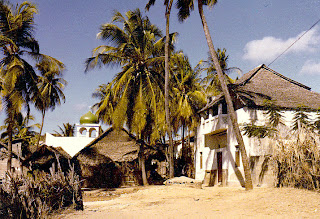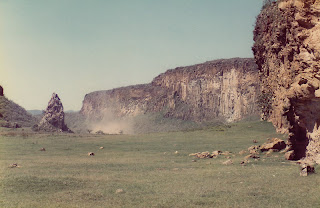On April 25th 1976 I was in Tarabuco in Bolivia. Tarabuco is a small rural town known for its Sunday market and its weaving. In nearby Sucre I had met up with Olivier, who I'd previously met in Nebaj. It was little surprise to find him in the centre of the region of Bolivia which had the best weaving. I spent a few days in Sucre with him looking for good weaving. Features we were looking for included representational figures, animal or human, and vegetable dyes.
 |
| My Tarabuco Chuspa: My picture |
For Tarabuco we took a small truck on the Saturday, so loaded with foreigners and locals that I could see almost nothing and couldn't reach warm clothing when the sun got lower. For the market we spent more time looking at weaving than inspecting the market, where there was little woven stuff on sale. Olivier had a Tarabucan contact he had met in Argentina who took us to the house of a mestizo woman, where there was a more expensive collection and I bought a chuspa, decorated with horses and llamas. A chuspa is a bag used for holding coca leaves and most of the men in the market were wearing them that day. The market was more colourful in the afternoon, fewer gringos, more Indians. The streets were all full of costume, like Guatemala. Particularly striking were the women's skirts, either brown with red and white designs, or black with white. There was a wide variety of hats and some good ponchos and mantas. As the afternoon progressed more and more aguardiente was being drunk from all sorts of tin cans and I noticed girls playing the charango. The women were drinking as well as the men and by night-time many were laid out on the ground.
The next morning we went out into the country, through eroded sandstone and past red rocks. After a river crossing we got away from the road and found a little plateau where it was peaceful. As we went along I stopped from time to time to take notes:
Tarabuco Countryside 2005: Picture by Adam Jones, CC Greener hills on either side, stony and not very high, a vulture circling over me. Fields of grain, barley or some sort of wheat, all over the plateau. Stone walls and deep sunken water-courses and a few adobe houses. There must be a village along the road as Indians keep walking past, perhaps past where there's a gap in the hills. At first most men were coming back led by their women after the night on the town, and some of them were loaded semi-conscious on mules, now many are going in the other direction too, sober. They wear the classic Tarabucan clothes; the men the soldier's helmet, the green/black shirt/blouse, the homespun trousers to the knee, the thick soled sandals with little straps. A manta tied round the neck carrying the poncho and one or two other things. A herd of donkeys, cows and pigs, tended by a woman and a girl, spinning. Three people sitting in a cornfield by a house. Two women passing, talking, one wears a red skirt, the other black, one of the men by the house is whistling. The barking dog is quiet. Two saddled donkeys on the rocky side. You hear the silence now with these little noises. Sparrows in the wind and the sound of charangos. Little shrubs with red pointed leaves by the rocky track, yellow flowers by a wall. A woman with a garlanded cross in her manta.
I still have my Tarabuco chuspa hanging in my study - see picture above. There are pictures of a more recent Tarabuco market here, and an article about Tarabuco weaving here. And there is a picture of a Tarabuco man with donkeys here.


































